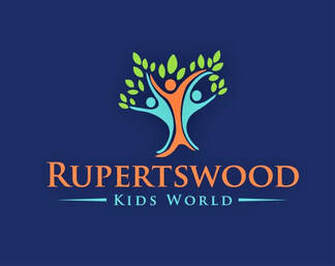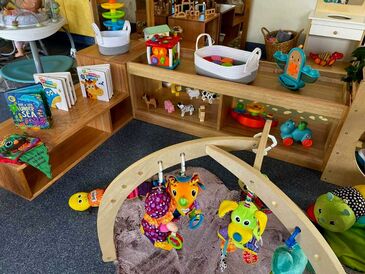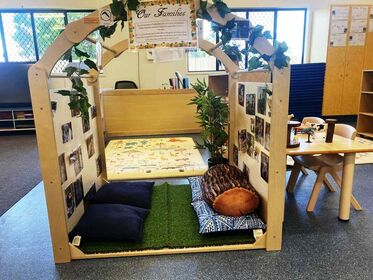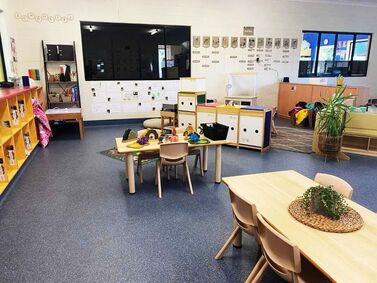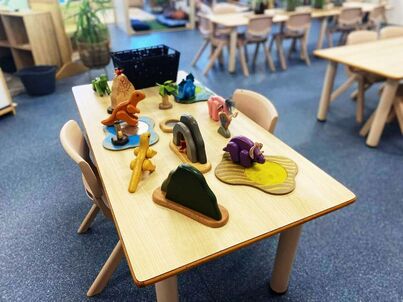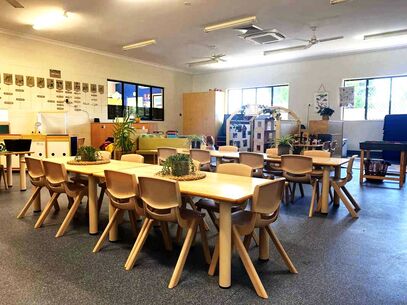Our Centre Rooms
NURSERY Room
The Nursery room at our childcare center caters for infants from birth to 15 months and plays a vital role in providing a safe, nurturing, and stimulating environment for our youngest.
Here's what you will find at our nursery:
1. Caring and Attentive Staff: The heart of the nursery room is the dedicated and well-trained caregivers who provide constant supervision, love, and attention to the infants.
2. Safety and Hygiene: The room is meticulously maintained for cleanliness and safety. All furniture, equipment, and toys are regularly sanitized to ensure a hygienic environment.
3. Cozy Cribs and Sleeping Areas: Infants need a comfortable and secure place to nap and rest. The nursery room is equipped with cozy cribs or bassinets, each tailored to meet the individual needs of the infants. Soft, breathable bedding and soothing lullabies help create a peaceful sleep environment.
4. Feeding and Changing Stations: There are designated areas for feeding and diaper changing. High-quality, safe feeding chairs are provided for caregivers to comfortably feed the infants. Changing stations are well-stocked with diapers, wipes, and disposal units.
5. Play and Learning Areas: Even the youngest children benefit from sensory stimulation and social interaction. The nursery room includes age-appropriate toys, mobiles, and soft play mats that engage infants' senses, encourage exploration, and support their cognitive development.
6. Daily Activity Schedule: A well-planned daily schedule ensures that infants have opportunities for play, tummy time, storytime, and sensory experiences. Staff members engage in interactive activities that promote early learning and bonding.
7. Personalized Attention: Each infant's individual needs and routines are respected. Caregivers work closely with parents to follow feeding and nap schedules and to accommodate specific care instructions.
8. Parent Communication: Open and clear communication with parents is essential. The nursery room maintains communication logs to inform parents about their child's daily activities, including feeding, napping, diaper changes, and any special moments.
9. Safety Measures: Security measures such as secure entry, and sign-in/out procedures ensure the safety and well-being of all children.
10. Warm and Soothing Decor: The nursery room is designed with soft decor to create a welcoming and tranquil atmosphere.
The nursery room in our childcare center is designed with the well-being and development of infants in mind. It's a safe, loving, and enriching space where infants can grow and thrive under the watchful care of our dedicated staff.
Here's what you will find at our nursery:
1. Caring and Attentive Staff: The heart of the nursery room is the dedicated and well-trained caregivers who provide constant supervision, love, and attention to the infants.
2. Safety and Hygiene: The room is meticulously maintained for cleanliness and safety. All furniture, equipment, and toys are regularly sanitized to ensure a hygienic environment.
3. Cozy Cribs and Sleeping Areas: Infants need a comfortable and secure place to nap and rest. The nursery room is equipped with cozy cribs or bassinets, each tailored to meet the individual needs of the infants. Soft, breathable bedding and soothing lullabies help create a peaceful sleep environment.
4. Feeding and Changing Stations: There are designated areas for feeding and diaper changing. High-quality, safe feeding chairs are provided for caregivers to comfortably feed the infants. Changing stations are well-stocked with diapers, wipes, and disposal units.
5. Play and Learning Areas: Even the youngest children benefit from sensory stimulation and social interaction. The nursery room includes age-appropriate toys, mobiles, and soft play mats that engage infants' senses, encourage exploration, and support their cognitive development.
6. Daily Activity Schedule: A well-planned daily schedule ensures that infants have opportunities for play, tummy time, storytime, and sensory experiences. Staff members engage in interactive activities that promote early learning and bonding.
7. Personalized Attention: Each infant's individual needs and routines are respected. Caregivers work closely with parents to follow feeding and nap schedules and to accommodate specific care instructions.
8. Parent Communication: Open and clear communication with parents is essential. The nursery room maintains communication logs to inform parents about their child's daily activities, including feeding, napping, diaper changes, and any special moments.
9. Safety Measures: Security measures such as secure entry, and sign-in/out procedures ensure the safety and well-being of all children.
10. Warm and Soothing Decor: The nursery room is designed with soft decor to create a welcoming and tranquil atmosphere.
The nursery room in our childcare center is designed with the well-being and development of infants in mind. It's a safe, loving, and enriching space where infants can grow and thrive under the watchful care of our dedicated staff.
TODDLERS ROOM
The toddler room in our Center, designed for children aged 15 months to 3 years, is a dynamic space carefully crafted to support their developmental needs and encourage exploration, social interaction, and learning.
Some of the services you will find include:
1. Knowledgeable and Caring Staff: The toddler room is staffed with experienced caregivers who understand the unique needs and characteristics of toddlers. They provide a nurturing and safe environment for the children, while also fostering their independence and social development.
2. Safety and Hygiene: Safety is a top priority, and the room is childproofed with safety gates, outlet covers, cushioned corners, and secure cabinet locks. Regular cleaning and disinfection protocols are in place to maintain a clean and hygienic environment.
3. Child-Centered Activities: The room is filled with a variety of age-appropriate toys, games, and activities that stimulate toddlers' senses and encourage their curiosity.
4. Circle Time Area: A dedicated space for circle time activities, such as reading, singing, and group discussions, fosters language development, social interaction, and early literacy skills.
5. Creative Arts Corner: An art station is provided where toddlers can express themselves through drawing, painting, and various art projects. This encourages creativity and fine motor skill development.
6. Play Kitchen and Dramatic Play Area: Toddlers love to engage in imaginative and pretend play. A play kitchen and a dramatic play area with costumes and props allow them to explore and imitate real-life situations, promoting social and emotional development.
7. Cozy Reading Nook: A comfortable reading nook filled with age-appropriate books encourages a love for reading and provides a quiet space for children to unwind and explore stories independently or with caregivers.
8. Toddler-Sized Furniture: Child-sized tables and chairs are available for group activities, art projects, and meals. This furniture is designed to accommodate the small stature of toddlers and promote independence.
9. Outdoor Play Area: Access to a secure outdoor play area is essential for physical activity, exploration, and gross motor skill development.
10. Routine and Consistency: A well-structured daily routine provides toddlers with a sense of security and predictability. Activities such as snacks, meals, naps, and outdoor play are scheduled to meet their needs.
11. Toilet Training Support: For children in the age range where toilet training begins, the toddler room is equipped with child-sized toilets and potties. Caregivers provide guidance and support during this important developmental milestone.
12. Parent Communication: Clear and open communication with parents is maintained through daily reports, meetings, and updates, ensuring that parents are informed about their child's progress, activities, and any special moments.
The toddler room in our childcare center is thoughtfully designed to foster the holistic development of toddlers. It provides a blend of structured learning experiences and opportunities for independent exploration in a secure and caring environment.
Some of the services you will find include:
1. Knowledgeable and Caring Staff: The toddler room is staffed with experienced caregivers who understand the unique needs and characteristics of toddlers. They provide a nurturing and safe environment for the children, while also fostering their independence and social development.
2. Safety and Hygiene: Safety is a top priority, and the room is childproofed with safety gates, outlet covers, cushioned corners, and secure cabinet locks. Regular cleaning and disinfection protocols are in place to maintain a clean and hygienic environment.
3. Child-Centered Activities: The room is filled with a variety of age-appropriate toys, games, and activities that stimulate toddlers' senses and encourage their curiosity.
4. Circle Time Area: A dedicated space for circle time activities, such as reading, singing, and group discussions, fosters language development, social interaction, and early literacy skills.
5. Creative Arts Corner: An art station is provided where toddlers can express themselves through drawing, painting, and various art projects. This encourages creativity and fine motor skill development.
6. Play Kitchen and Dramatic Play Area: Toddlers love to engage in imaginative and pretend play. A play kitchen and a dramatic play area with costumes and props allow them to explore and imitate real-life situations, promoting social and emotional development.
7. Cozy Reading Nook: A comfortable reading nook filled with age-appropriate books encourages a love for reading and provides a quiet space for children to unwind and explore stories independently or with caregivers.
8. Toddler-Sized Furniture: Child-sized tables and chairs are available for group activities, art projects, and meals. This furniture is designed to accommodate the small stature of toddlers and promote independence.
9. Outdoor Play Area: Access to a secure outdoor play area is essential for physical activity, exploration, and gross motor skill development.
10. Routine and Consistency: A well-structured daily routine provides toddlers with a sense of security and predictability. Activities such as snacks, meals, naps, and outdoor play are scheduled to meet their needs.
11. Toilet Training Support: For children in the age range where toilet training begins, the toddler room is equipped with child-sized toilets and potties. Caregivers provide guidance and support during this important developmental milestone.
12. Parent Communication: Clear and open communication with parents is maintained through daily reports, meetings, and updates, ensuring that parents are informed about their child's progress, activities, and any special moments.
The toddler room in our childcare center is thoughtfully designed to foster the holistic development of toddlers. It provides a blend of structured learning experiences and opportunities for independent exploration in a secure and caring environment.
JUNIOR KINDY
Our Junior Kindy room in our Centre is designed to cater to the developmental needs of children aged 2 to 3 years. This is a crucial age group where children are rapidly developing their language, motor, social, and cognitive skills.
We provide the following:
1. Experienced and Caring Educators: The Junior Kindy room is staffed with highly trained and experienced early childhood educators who understand the specific needs and characteristics of children in this age group.
2. Age-Appropriate Activities: The room is filled with a wide range of age-appropriate activities and materials that support the development of fine and gross motor skills, early literacy and numeracy, and creativity. This may include puzzles, building blocks, art supplies, and more.
3. Learning Centers: The room is organized into learning centers that promote different areas of development, such as a reading corner, an art area, a science exploration area, and a dramatic play zone. These centers encourage children to engage in a variety of activities and experiences.
4. Circle Time: Circle time activities continue to play a significant role in the Junior Kindy room. This is a time for group activities, singing, reading stories, and engaging in discussions, promoting language development, social interaction, and early literacy.
5. Outdoor Play Area: A safe and well-equipped outdoor play area allows children to engage in physical activities, explore nature, and further develop their gross motor skills. Play equipment like swings, slides, and sandpits are designed for their age group.
6. Social Development: The Junior Kindy room places a strong emphasis on social development. Children are encouraged to play and interact with their peers, helping them develop important social skills, such as sharing, cooperation, and conflict resolution.
7. Toilet Training Support: For children who are in the process of toilet training, the room is equipped with child-sized toilets and potties.
8. Daily Routine: A consistent daily routine is followed, which includes structured activities, meal times, naps, and outdoor play. This routine provides a sense of security and helps children understand what to expect throughout the day.
9. Art and Creative Expression: The room offers a variety of art supplies, giving children the opportunity to express their creativity through drawing, painting, and other art activities.
10. Parent Communication: Communication with parents is maintained through daily reports, meetings, and updates.
The Junior Kindy room is designed to provide a supportive and enriching environment for children in the 2-3 age group. It balances structured learning experiences with opportunities for imaginative play and exploration, fostering their overall development and preparing them for the transition to more structured learning in the future.
We provide the following:
1. Experienced and Caring Educators: The Junior Kindy room is staffed with highly trained and experienced early childhood educators who understand the specific needs and characteristics of children in this age group.
2. Age-Appropriate Activities: The room is filled with a wide range of age-appropriate activities and materials that support the development of fine and gross motor skills, early literacy and numeracy, and creativity. This may include puzzles, building blocks, art supplies, and more.
3. Learning Centers: The room is organized into learning centers that promote different areas of development, such as a reading corner, an art area, a science exploration area, and a dramatic play zone. These centers encourage children to engage in a variety of activities and experiences.
4. Circle Time: Circle time activities continue to play a significant role in the Junior Kindy room. This is a time for group activities, singing, reading stories, and engaging in discussions, promoting language development, social interaction, and early literacy.
5. Outdoor Play Area: A safe and well-equipped outdoor play area allows children to engage in physical activities, explore nature, and further develop their gross motor skills. Play equipment like swings, slides, and sandpits are designed for their age group.
6. Social Development: The Junior Kindy room places a strong emphasis on social development. Children are encouraged to play and interact with their peers, helping them develop important social skills, such as sharing, cooperation, and conflict resolution.
7. Toilet Training Support: For children who are in the process of toilet training, the room is equipped with child-sized toilets and potties.
8. Daily Routine: A consistent daily routine is followed, which includes structured activities, meal times, naps, and outdoor play. This routine provides a sense of security and helps children understand what to expect throughout the day.
9. Art and Creative Expression: The room offers a variety of art supplies, giving children the opportunity to express their creativity through drawing, painting, and other art activities.
10. Parent Communication: Communication with parents is maintained through daily reports, meetings, and updates.
The Junior Kindy room is designed to provide a supportive and enriching environment for children in the 2-3 age group. It balances structured learning experiences with opportunities for imaginative play and exploration, fostering their overall development and preparing them for the transition to more structured learning in the future.
SENIOR KINDY
The Senior Kindy room is designed for children aged 3 to 4 years. At this stage, children are becoming more independent and are eager to explore and learn about the world around them. The Senior Kindy room is specifically structured to provide a rich and stimulating environment that supports their cognitive, social, and emotional development, with all the facilities in the Junior Kindy rooms.
The Senior Kindy room is designed to encourage independence, critical thinking, and social development while preparing children for the transition to formal education. It provides a nurturing and engaging environment where children can further develop the skills and knowledge they need for success in school and in life.
The Senior Kindy room is designed to encourage independence, critical thinking, and social development while preparing children for the transition to formal education. It provides a nurturing and engaging environment where children can further develop the skills and knowledge they need for success in school and in life.
KINDERGARTEN
The Kindergarten room or early childhood education facility is designed to provide a structured and enriched learning environment for children typically aged 4 to 5 years.
This room is often a transitional space between preschool and formal schooling, aiming to prepare children for a successful transition to kindergarten.
You will find the following:
1. Qualified and Experienced Educators: The Kindergarten room is staffed with qualified and experienced early childhood educators who understand the educational and developmental needs of young children. These educators create a supportive and engaging environment that fosters learning and independence.
2. Learning Centers: The room is typically divided into various learning centers that focus on different aspects of development and learning.
3. Structured Educational Activities: The curriculum includes structured educational activities and lessons that help children develop foundational skills in reading, math, science, and social studies. These activities are designed to align with pre-kindergarten and kindergarten standards.
4. Circle Time: Circle time remains an important part of the daily routine. During this time, children participate in group activities such as Storytime, group discussions, singing, and early literacy and numeracy activities.
5. Outdoor Play Area: A secure outdoor play area continues to be important for physical activity and social interaction. It may include more advanced play equipment, sports facilities, and space for group games in our recently totally revamped outdoor area.
6. Preparing for School: The Kindergarten room focuses on preparing children for formal schooling. This includes activities that promote school readiness, such as pre-reading and pre-writing skills, math concepts, and development of social and emotional skills necessary for a classroom setting.
7. Independence and Self-Help Skills: Children are encouraged to develop and demonstrate self-help skills, such as dressing themselves, using the toilet independently, and personal responsibility for their belongings.
8. Assessment and Documentation: Educators may engage in ongoing assessment and documentation of each child's progress and development to identify individual strengths and areas for growth.
9. Parent Communication: Regular communication with parents is maintained through progress reports, parent-teacher conferences, newsletters, and updates to ensure parents are informed about their child's learning and development.
The Kindergarten room is designed to provide a supportive, structured, and educational environment where children can continue to develop the skills and knowledge needed for a successful transition to formal schooling.
It aims to foster a love of learning and help children grow academically, socially, and emotionally.
This room is often a transitional space between preschool and formal schooling, aiming to prepare children for a successful transition to kindergarten.
You will find the following:
1. Qualified and Experienced Educators: The Kindergarten room is staffed with qualified and experienced early childhood educators who understand the educational and developmental needs of young children. These educators create a supportive and engaging environment that fosters learning and independence.
2. Learning Centers: The room is typically divided into various learning centers that focus on different aspects of development and learning.
3. Structured Educational Activities: The curriculum includes structured educational activities and lessons that help children develop foundational skills in reading, math, science, and social studies. These activities are designed to align with pre-kindergarten and kindergarten standards.
4. Circle Time: Circle time remains an important part of the daily routine. During this time, children participate in group activities such as Storytime, group discussions, singing, and early literacy and numeracy activities.
5. Outdoor Play Area: A secure outdoor play area continues to be important for physical activity and social interaction. It may include more advanced play equipment, sports facilities, and space for group games in our recently totally revamped outdoor area.
6. Preparing for School: The Kindergarten room focuses on preparing children for formal schooling. This includes activities that promote school readiness, such as pre-reading and pre-writing skills, math concepts, and development of social and emotional skills necessary for a classroom setting.
7. Independence and Self-Help Skills: Children are encouraged to develop and demonstrate self-help skills, such as dressing themselves, using the toilet independently, and personal responsibility for their belongings.
8. Assessment and Documentation: Educators may engage in ongoing assessment and documentation of each child's progress and development to identify individual strengths and areas for growth.
9. Parent Communication: Regular communication with parents is maintained through progress reports, parent-teacher conferences, newsletters, and updates to ensure parents are informed about their child's learning and development.
The Kindergarten room is designed to provide a supportive, structured, and educational environment where children can continue to develop the skills and knowledge needed for a successful transition to formal schooling.
It aims to foster a love of learning and help children grow academically, socially, and emotionally.
Rupertswood Kids World 2015 ®©
3 Ridge Drive, Alice River,
Townsville Qld 4817
07 47888233
E: [email protected]
W: rupertswoodkidsworld.com.au
3 Ridge Drive, Alice River,
Townsville Qld 4817
07 47888233
E: [email protected]
W: rupertswoodkidsworld.com.au
